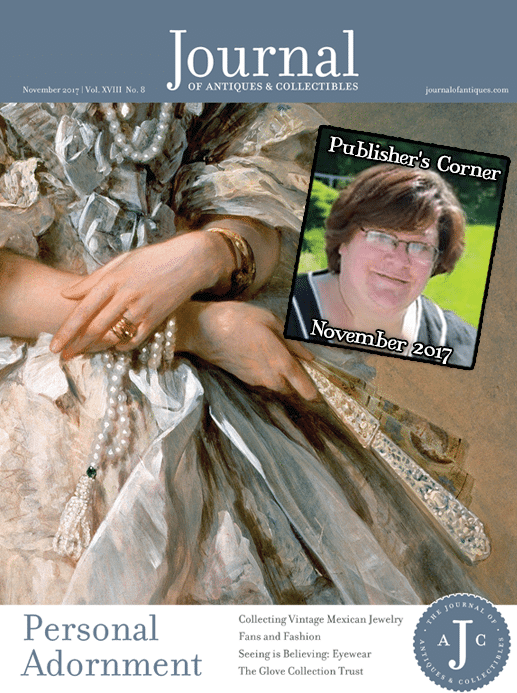Collectible Adornments
By Maxine Carter-Lome
An adornment is generally an accessory or ornament worn to enhance the beauty or status of the wearer. They are often worn to embellish, enhance, or distinguish the wearer, and to define cultural, social, or religious status within a specific community. When worn to show economic status, the items are often either rare or prohibitively expensive to others. Adornments are usually colorful, and worn to attract attention.
Nothing is more of a personal adornment than jewelry. Historically, jewelry was worn as a statement of wealth, power, and religion. As a fashion accessory it expresses the wearer’s style and taste. For collectors it is about the materials, maker, history, era, and other factors that separate what they collect from the rest in this vast category. Jamie Shenkman, a dealer of antique and vintage jewelry, is a passionate collector of vintage Mexican jewelry. In her article “Collecting Mexican Jewelry”, she provides a great history lesson on the rise in popularity of traditional Mexican jewelry and craft in the first half of the 20th century, why it is enjoying a resurgence, and the opportunities that exist for collectors in vintage pieces made from lesser-known but no less highly skilled silversmiths.
The fan has a long and interesting history as both a practical item for cooling off on a hot summer’s day and as a fashion statement. Evidence of hand fans dates back to the Greeks, Egyptians, Chinese and many other cultures; it wasn’t until the 1500s that fans became a necessary fashion accessory and item of personal adornment. That story is told by Kathryn Hanna of the Fan Association of North America in her article “Fans and Fashion”.
Although eyeglasses have been around since medieval times (illustrations exist of early Chinese and Italians wearing them), they were originally regarded as necessary evils. Functional and unattractive, they were also hand-crafted, and thus affordable for only a select few. Fast forward to 1948 and the introduction of the first molded frame, and eyewear quickly moved into the realms of fashion accessory and personal adornment, with many top fashion designers adding their name and brand to a higher-end strata of frames. Donald Brian-Johnson looks at some of the more distinctive eyewear trends of the 1950s and ’60s, and their value in today’s market in “Seeing is Believing”.
Gloves date back to ancient societies. Initially created out of necessity-insulation from the heat or cold or perhaps to prevent scratched hands while working with hostile and harsh materials-over time, the glove also became a fashion accessory for both men and women, and an outward and visible sign of a person’s style, status, and wealth. These gloves were often crafted of finer leathers such as doeskin and kid (lamb), beautifully fringed and edged, richly embroidered often with gold thread or colorful silk threads, and adorned with precious stones. In 1922, archeologists discovered in the tomb of Tutankhamen remains of gloves decorated with a plaited, scale-motif design. Managing Editor Judy Gonyeau introduces you to some of the more historic gloves in history from “The Glove Collection Trust” in this month’s Great Collections.
For gentlemen, the walking stick or cane was another item of personal adornment. Initially used by Shepherds and travelers (a nice hefty stick was an excellent way to protect against thieves and to keep animals in line), over time it became a symbol for power and strength, and eventually authority and social prestige. Rulers of many cultures, past and present, have carried some form of walking stick or staff. Ancient Greek gods were often depicted with a staff in hand. In the late 17th Century oak sticks were carried, especially by the Puritans. The transfer from walking sticks to canes as a statement piece of fashion for men continues well into the 20th Century. From time to time, women also carried walking sticks or canes as a fashion accessory. For today’s men and women hiking along the trails, walking sticks have once again come into fashion, and the older, hand-fashioned works of art are highly collectible and command strong prices at auction based on their uniqueness, provenance, materials and other factors of distinction.
While trends and styles come and go in the personal accessories market, time inevitably makes the best and most iconic examples of these items of personal adornment, desirable collectibles and beautiful to look at.
-
- Assign a menu in Theme Options > Menus WooCommerce not Found





Related posts: